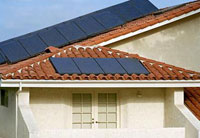Solar homes attract hundreds in Washington's National Mall
Solar power may soon be used in common homes all across the globe. Several of such homes powered by the sun have already been assembled in the National Mall, a park in the shadow of the Washington Monument. The novelty became a great attraction for people during the past weekend. Many of them came to the Mall to see what these technology-filled homes were all about.

Even storm clouds and drizzle did not keep the curious from standing in long lines one afternoon to look at the one-bedroom homes that had been assembled by students from 16 states, Puerto Rico and three foreign countries.
As the rain fell, batteries hidden beneath attached decks and porches provided the juice from energy that had been absorbed on sunny days.
Judges ranked each of the houses on 10 criteria, from architecture to market viability to engineering to livability. They required students to wash clothes, prepare meals, run a television, maintain comfortable temperatures and even use excess power to drive a plug-in electric car - and finish the week having used no more electricity than the sun provided.
A team of students from Germany's Technische Universitat Darmstadt won the weeklong competition as judges concluded their box-like dwelling was the most efficient, well-designed and well-engineered home in the competition. It featured three walls of solar cell-imbedded louvers that were adjusted automatically by a computer to best take advantage of the sun.
The German design "pushed the envelop on all levels," Energy Secretary Samuel Bodman said in announcing the winner Friday, calling it "the house people have been lining up all week to watch."
A team from the University of Maryland finished second. Visitors touring their house were attracted by an indoor waterfall that provided a novel way to use a liquid desiccant to soak up humidity so less energy was needed for cooling.
"The concept is sound," said Brian Borak, 25, a chemistry major, adding that it has been used in industrial applications, but never in a residential situation. The university is thinking of filing a patent.
Renewable energy sources - mostly wind turbines - account for a little more than 2 percent of electricity production. A very small percentage comes from solar, or photovoltaic, cells such as those used in the houses on the Mall, according the Energy Department.
But in the two years since the last Solar Decathlon, the competing house designs have become more mainstream, according to judges and participants. For the first time a category of "market appeal" was added to the criteria on which teams were judged. While the prototype homes were said to cost $500,000 (EUR 350,000) or more to design, ship and erect, they also contained many features that are commercially available, according to competition organizers.
"In 2005 (the houses) were experiments. This year they're not. ... They're an example of what can be done," said Bob Burt, a building consultant who was one of the judges ranking the homes on market appeal. "There are a couple of houses that when I first walked in I said, 'Yeah, I could live here."'
The winning German entry was cited not only for its solar technology and energy saving, but for its efficient use of space and multifunction design. Its solar cell-imbedded louvers were a source of both shade and energy. The furniture was made so it could be lowered and hidden beneath the floor when not in use to make rooms multifunctional.
The large crowds and high level of interest surprised many of the students. "We're also surprised that they like our strange ideas," said Andreas Pilot, 28, an architect student and member of the German team.
Subscribe to Pravda.Ru Telegram channel, Facebook, RSS!


